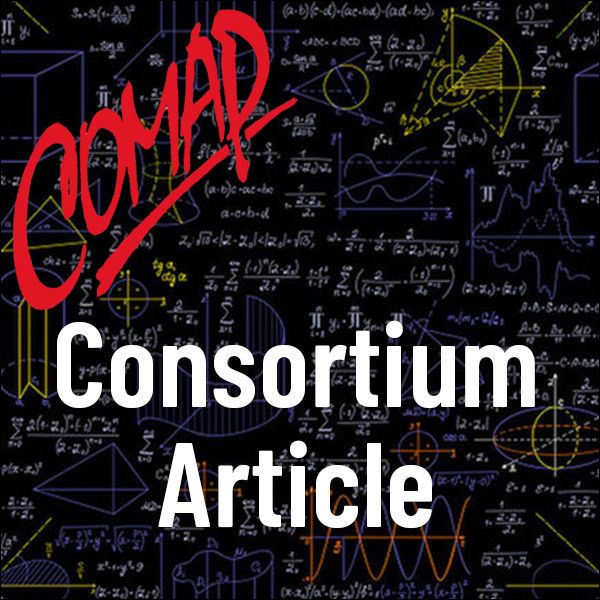Integer Length Tetrahedra
Author: Joseph Malkevitch
Little is known about collections of 6 positive integer lengths which can be the edge lengths of a tetrahedron.
A tetrahedron (see Figure 1) in 3‑dimensional space arises from taking the intersection of all convex (given two points u and v in the set, all points on the line segment joining u and v including u and v lie in the set) sets containing four points that don’t lie in a plane. A tetrahedron has four vertices, four faces (each a triangle) and six edges. Often people make physical models of tetrahedra with sticks or membranes (panels of paper, cardboard, or plastic) and though these models “represent” something convex, the models themselves typically are not convex. Little is known about collections of six positive integer lengths which can be the edge lengths of a tetrahedron. What follows are some ideas for looking at some special cases of the general question of sextuples of positive integers which can arise as edge lengths of a tetrahedron.
Note: The information below was created with the assistance of AI.
Level of Mathematics
This article is best suited for advanced high school students (Grades 11–12) and early undergraduate students with strong mathematical backgrounds, particularly those with an interest in mathematical research or enrichment activities.
It engages with:
-
Geometric constructions in 3D
-
Number theory and integer partitions
-
Graph theory concepts (like spanning trees)
-
Linear algebra and determinants (Cayley-Menger determinant)
-
Combinatorics (labelings, permutations, congruence classes)
The problems are open-ended and exploratory, making it ideal for honors, gifted, or math circle environments.
Application Areas
While theoretical in nature, the research connects to broader applications in:
-
Computational geometry (used in 3D modeling and computer graphics)
-
Mathematical modeling of solids and polyhedral structures
-
Materials science and chemistry, where tetrahedral configurations arise in molecular geometry
-
Graph theory applications in network design
-
Educational enrichment, especially for nurturing creativity and exploration in mathematics
It also promotes mathematical thinking through the interplay of algebra, geometry, and combinatorics.
Prerequisites
Students engaging with this material should have knowledge in the following areas:
-
Geometry:
-
Understanding of tetrahedra, faces, edges, and vertices
-
Familiarity with the triangle inequality
-
-
Algebra and Linear Algebra:
-
Basic matrix operations and determinants (especially Cayley-Menger determinant to compute volume)
-
-
Combinatorics and Number Theory:
-
Concepts of permutations and partitions
-
Familiarity with twin primes and integer factorization
-
-
Graph Theory (Introductory level):
-
Trees and spanning trees
-
Understanding of graphs representing polyhedra
-
No advanced calculus is required, but an interest in problem-solving and mathematical rigor is assumed.
Subject Matter
The article explores the fascinating problem of determining which sets of six positive integers can represent the edge lengths of a tetrahedron. Key ideas include:
-
Tetrahedral Realizability:
-
Not all combinations of 6 lengths yield a valid tetrahedron.
-
Requires satisfying the triangle inequality on all four triangular faces and producing a positive volume via the Cayley-Menger determinant.
-
-
Integer Partitions and Geometry:
-
Linking number theory (e.g., 2025 = 3⁴ × 5²) to possible tetrahedral structures.
-
Classifying realizable tetrahedra based on partition types (e.g., 3,3 or 4,2).
-
-
Incongruent Realizations:
-
Counting distinct tetrahedra (up to congruence) for a given set of edge lengths.
-
Considering automorphisms of tetrahedral graphs to understand symmetry and congruence.
-
-
Interchange Tetrahedra:
-
For edge sets involving two distinct lengths (e.g., 3 and 5), swapping the roles of the lengths and investigating whether the resulting tetrahedron still exists.
-
-
Geometric Nets and Folding:
-
Exploring patterns (nets) that fold into tetrahedra, involving concepts from graph theory (spanning trees).
-
-
Warm-up and Research Problems:
-
Students are invited to explore sets like {3,3,3,3,5,5} or {3,3,3,5,5,5} to determine the realizability of tetrahedra and uncover general patterns.
-
Correlation to Mathematics Standards
Common Core State Standards (CCSSM):
-
HS.G-GMD.B.4: Identify and describe three-dimensional objects.
-
HS.G-GPE.B.7: Use coordinates to compute perimeters of polygons and areas of triangles.
-
HS.A-CED.A.1–4: Create equations and inequalities in one variable and use them to solve problems.
-
HS.S-CP.A.1–5: Understand and apply concepts of permutations and combinations.
NCTM Process and Content Standards:
-
Geometry: Analyze characteristics and properties of 3D shapes; explore geometric relationships.
-
Algebra: Represent and analyze mathematical situations using algebraic symbols.
-
Problem Solving: Apply and adapt a variety of appropriate strategies to solve problems.
-
Connections: Recognize and apply mathematics in contexts outside of mathematics.
-
Reasoning and Proof: Develop and evaluate mathematical arguments and proofs.
This article exemplifies rich mathematical modeling, promotes exploration and conjecture, and aligns with goals of student-centered research and discovery-based learning.

Mathematics Topics:
Application Areas:
Prerequisites:
You must have a Full Membership to download this resource.
If you're already a member, login here.